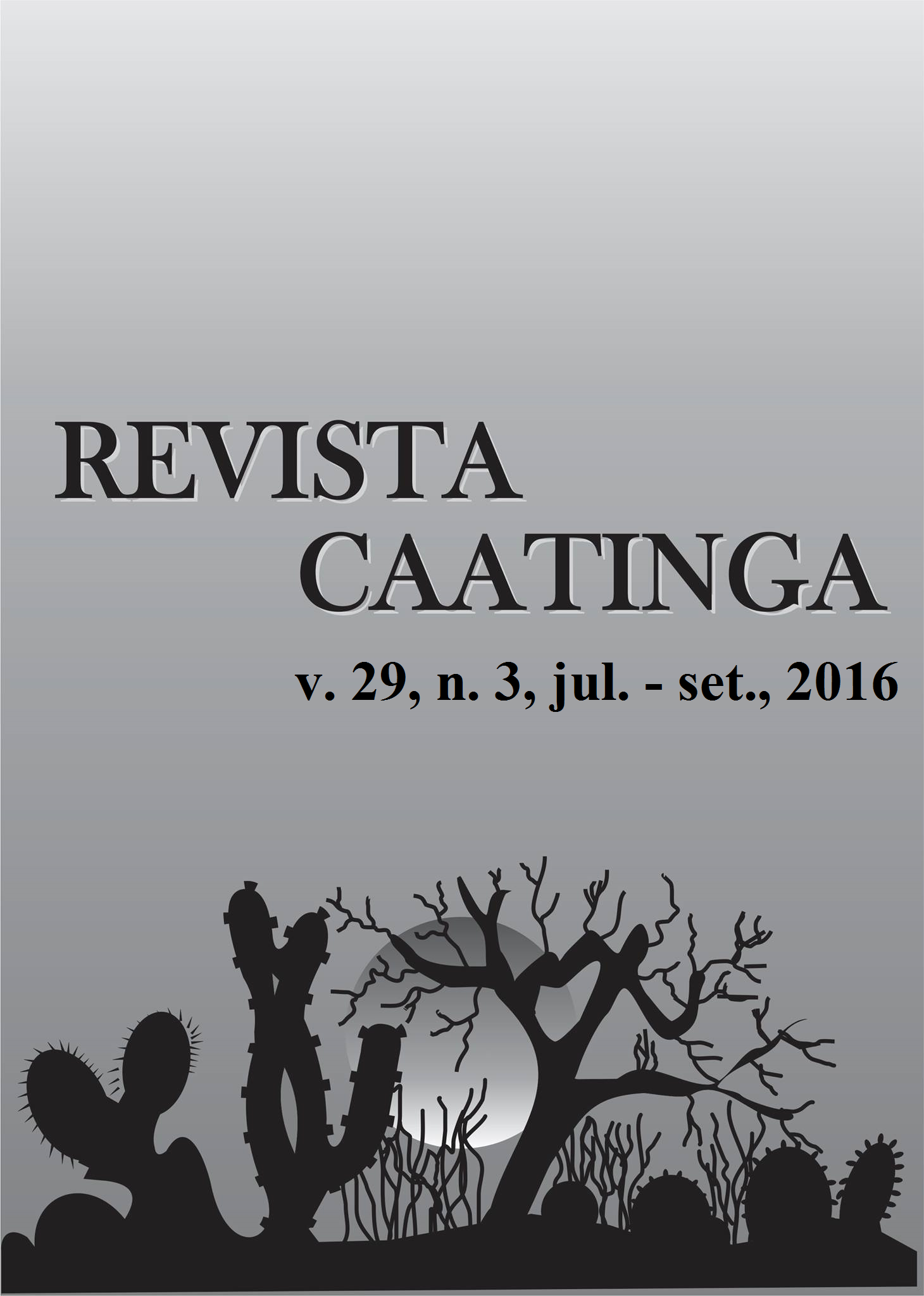ANTIBACTERIAL POTENTIAL OF NATIVE PLANTS FROM THE CAATINGA BIOME AGAINST Staphylococcus spp. ISOLATES FROM SMALL RUMINANTS WITH MASTITIS
DOI:
https://doi.org/10.1590/1983-21252016v29n328rcKeywords:
Natural extract. Goats. Ewes. Intramammary infection. Therapy.Abstract
The aim of the present study is to assess the antibacterial potential of plants from the Caatinga biome of the semi-arid region of Pernambuco, against Staphylococcus spp. isolates from cases of subclinical mastitis in small ruminants, such as goats and ewes. Ethanolic extracts of the following plants from the Caatinga biome were used: Encholirium spectabile Mart., Bromelia laciniosa Mart., Neoglaziovia variegata Mez., Amburana cearensis (Fr. Allem.) A.C.Smith, Hymenaea martiana Hayne, and Selaginella convoluta Spring. The presence of phenolic components, flavonoids, steroids, and terpenoids was verified for all the tested extracts. The mean minimal bactericide concentrations of the extracts of E. spectabile, B. laciniosa, and N. variegate were 11,379, 11,405, and 11,995 µg/mL, respectively. The highest inhibitory activities were observed for A. cearensis and H. martiana, which inhibited 88.1 and 99.4% of the isolates, respectively. Other studies focusing on in vitro and in vivo activities should be undertaken.Downloads
References
BÔAS, G. K. V.; GADELHA, C. A. G. Oportunidades na indústria de medicamentos e a lógica do desenvolvimento local baseado nos biomas brasileiros: bases para a discussão de uma política nacional. Cadernos de Saúde Pública, Rio de Janeiro, v. 23, n. 6, p. 1463-1471, 2007.
CANUTO, K. M.; SILVEIRA, E. R. Constituintes químicos da casca do caule de Amburana cearensis A. C. SMITH. Química Nova, São Paulo, v. 29, n. 6, p. 1241-1243, 2006.
Levy, S. B. Factors impacting on the problem of antibiotic resistance. Journal Antimicrobial Chemotherapy, Oxford, v. 49, n. 1, p. 25-30, 2002.
CLSI. Performance standards for antimicrobial disk and dilution susceptibility tests for bacteria isolated from animals. Clinical and Laboratory Standards Institute. Approved Standard, 3rd ed. CLSI/NCCLS document M31 - A3. Wayne, 2008.
COS, P. et al. Anti-infective potential of natural products: How to develop a stronger in vitro ‘proof-of-concept’. Journal of Ethnopharmacology, Amsterdã, v. 106, n. 3, p. 290-302, 2006.
CUSHNIE, T. P. T.; LAMB, A. J. Recent advances in understanding the antibacterial properties of flavonoids. International Journal Antimicrobial Agents, Amsterdã, v. 38, n. 2, p. 99-107, 2011.
DUARTE, M. C. T. Atividade antimicrobiana de plantas medicinais e aromáticas utilizadas no Brasil. Multiciência, Campinas, v. 7, n. 10, p. 1-16, 2006.
FALKENBERG, M. B.; SANTOS, R. I.; SIMÕES, C. M. O. Introdução à análise fitoquímica. In.: SIMÕES et al. Farmacognosia: da planta ao medicamento. 5 ed. Porto Alegre/Florianópolis: Ed. UFRGS/Ed. UFSC, 2003. p. 165-181.
GRANATO, D. et al. Chemical and biological evaluation of rejects from the wood industry. Brazilian Archives of Biology and Technology, Curitiba, v. 48, p. 237-241, 2005.
HIRAI, R.Y.; PRADO, J. Selaginellaceae Willk. no Estado de São Paulo, Brasil. Revista Brasileira de Botânica, São Paulo, v. 23, n. 3, p. 313-339, 2000.
HOLT J. G. Bergey’s manual of determinative bacteriology. Williams & Wilkins, Baltimore, 1994, 787 p.
KÜMMERER, K. Resistance in the environment. Journal of Antimicrobial Chemotherapy, Oxford, v. 54, n. 2, p. 311-320, 2004.
LEAL, L. K. A. M. et al. Amburoside A, a glucoside from Amburana cearensis protects mesencephalic cells against 6-hydroxydopamine-induced neurotoxicity. Neuroscience Letters, Irlanda, v. 388, n., 2, p. 86-90, 2005.
MAIGA, A. et al. A survey of toxic plants on the market in the district of Bamako, Mali: traditional knowledge compared with a literature search of modern pharmacology and toxicology. Journal of Ethnopharmacology, Amsterdã, v. 96, n. 1-2, p. 183-193, 2005.
MANETTI, L. M.; DELAPORTE, R. H.; JAVERDE JUNIOR, A. Metabólitos secundários da família Bromeliaceae. Química Nova, São Paulo, v. 32, n. 7, p. 1-13, 2009.
MATOS, F. J. A. Introdução à fitoquímica experimental. 2. ed. Fortaleza, CE: UFC, 1997. 141 p.
MORAES, A. C. A. et al. Triagem fitoquímica e atividade antinociceptiva do extrato etanólico bruto de Selaginella convoluta (Arn.) Spring (Selaginellacae). In: SIMPÓSIO DE PLANTAS MEDICINAIS DO BRASIL, 19, 2006, Salvador, BA. Anais… Salvador, 2006.
NOGUEIRA, R. T. et al. Clerodane-type diterpenes from the seed pods of Hymenaea courbaril var. stilbocarpa. Phytochemistry, Londres, v. 58, n. 8, p. 1153-1157, 2001.
SCHUCH, L. F. D. et al. Cinética da atividade antibacteriana in vitro de extratos naturais frente a micro-organismos relacionados à mastite bovina. Ciência Animal Brasileira, Goiânia, v. 9, n. 1, p. 161-169, 2008.
TAPONEN, S.; PYÖRÄLÄ, S. Coagulase-negative staphylococci as cause of bewes mastitis – Not so different from Staphylococcus aureus? Veterinary Microbiology, Amsterdã, v. 134, n. 1-2, p. 29-36, 2009.
USHIMARU, P. I. et al. Antibacterial activity of medicinal plant extracts. Brazilian Journal of Microbiology, São Paulo, v. 38, n. 4, p. 717-719, 2007.
Downloads
Published
Issue
Section
License
Os Autores que publicam na Revista Caatinga concordam com os seguintes termos:
a) Os Autores mantêm os direitos autorais e concedem à revista o direito de primeira publicação, com o trabalho simultaneamente licenciado sob a Licença Creative Commons do tipo atribuição CC-BY, para todo o conteúdo do periódico, exceto onde estiver identificado, que permite o compartilhamento do trabalho com reconhecimento da autoria e publicação inicial nesta revista, sem fins comerciais.
b) Os Autores têm autorização para distribuição não-exclusiva da versão do trabalho publicada nesta revista (ex.: publicar em repositório institucional ou como capítulo de livro), com reconhecimento de autoria e publicação inicial nesta revista.
c) Os Autores têm permissão e são estimulados a publicar e distribuir seu trabalho online (ex.: em repositórios institucionais ou na sua página pessoal) a qualquer ponto antes ou durante o processo editorial, já que isso pode gerar alterações produtivas, bem como aumentar o impacto e a citação do trabalho publicado (Veja O Efeito do Acesso Livre).







